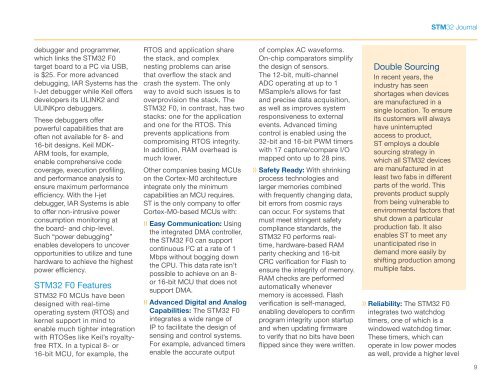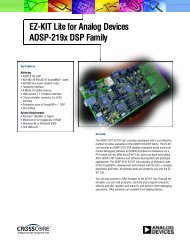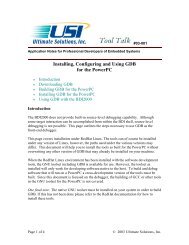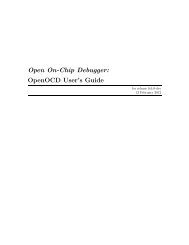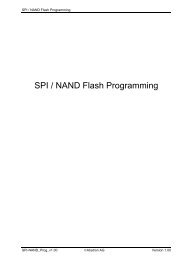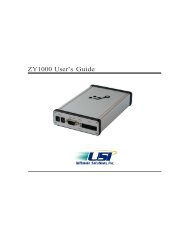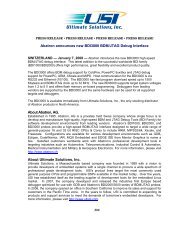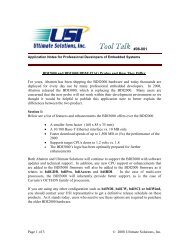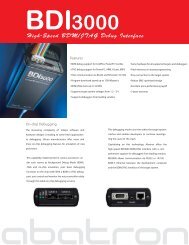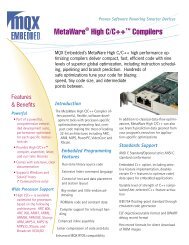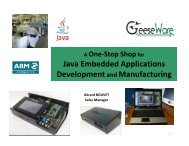STM32 Journal - Digikey
STM32 Journal - Digikey
STM32 Journal - Digikey
Create successful ePaper yourself
Turn your PDF publications into a flip-book with our unique Google optimized e-Paper software.
<strong>STM32</strong> <strong>Journal</strong><br />
debugger and programmer,<br />
which links the <strong>STM32</strong> F0<br />
target board to a PC via USB,<br />
is $25. For more advanced<br />
debugging, IAR Systems has the<br />
I-Jet debugger while Keil offers<br />
developers its ULINK2 and<br />
ULINKpro debuggers.<br />
These debuggers offer<br />
powerful capabilities that are<br />
often not available for 8- and<br />
16-bit designs. Keil MDK-<br />
ARM tools, for example,<br />
enable comprehensive code<br />
coverage, execution profiling,<br />
and performance analysis to<br />
ensure maximum performance<br />
efficiency. With the I-jet<br />
debugger, IAR Systems is able<br />
to offer non-intrusive power<br />
consumption monitoring at<br />
the board- and chip-level.<br />
Such “power debugging”<br />
enables developers to uncover<br />
opportunities to utilize and tune<br />
hardware to achieve the highest<br />
power efficiency.<br />
<strong>STM32</strong> F0 Features<br />
<strong>STM32</strong> F0 MCUs have been<br />
designed with real-time<br />
operating system (RTOS) and<br />
kernel support in mind to<br />
enable much tighter integration<br />
with RTOSes like Keil’s royaltyfree<br />
RTX. In a typical 8- or<br />
16-bit MCU, for example, the<br />
RTOS and application share<br />
the stack, and complex<br />
nesting problems can arise<br />
that overflow the stack and<br />
crash the system. The only<br />
way to avoid such issues is to<br />
overprovision the stack. The<br />
<strong>STM32</strong> F0, in contrast, has two<br />
stacks: one for the application<br />
and one for the RTOS. This<br />
prevents applications from<br />
compromising RTOS integrity.<br />
In addition, RAM overhead is<br />
much lower.<br />
Other companies basing MCUs<br />
on the Cortex-M0 architecture<br />
integrate only the minimum<br />
capabilities an MCU requires.<br />
ST is the only company to offer<br />
Cortex-M0-based MCUs with:<br />
〉〉 Easy Communication: Using<br />
the integrated DMA controller,<br />
the <strong>STM32</strong> F0 can support<br />
continuous I 2 C at a rate of 1<br />
Mbps without bogging down<br />
the CPU. This data rate isn’t<br />
possible to achieve on an 8-<br />
or 16-bit MCU that does not<br />
support DMA.<br />
〉〉 Advanced Digital and Analog<br />
Capabilities: The <strong>STM32</strong> F0<br />
integrates a wide range of<br />
IP to facilitate the design of<br />
sensing and control systems.<br />
For example, advanced timers<br />
enable the accurate output<br />
of complex AC waveforms.<br />
On-chip comparators simplify<br />
the design of sensors.<br />
The 12-bit, multi-channel<br />
ADC operating at up to 1<br />
MSample/s allows for fast<br />
and precise data acquisition,<br />
as well as improves system<br />
responsiveness to external<br />
events. Advanced timing<br />
control is enabled using the<br />
32-bit and 16-bit PWM timers<br />
with 17 capture/compare I/O<br />
mapped onto up to 28 pins.<br />
〉〉 Safety Ready: With shrinking<br />
process technologies and<br />
larger memories combined<br />
with frequently changing data,<br />
bit errors from cosmic rays<br />
can occur. For systems that<br />
must meet stringent safety<br />
compliance standards, the<br />
<strong>STM32</strong> F0 performs realtime,<br />
hardware-based RAM<br />
parity checking and 16-bit<br />
CRC verification for Flash to<br />
ensure the integrity of memory.<br />
RAM checks are performed<br />
automatically whenever<br />
memory is accessed. Flash<br />
verification is self-managed,<br />
enabling developers to confirm<br />
program integrity upon startup<br />
and when updating firmware<br />
to verify that no bits have been<br />
flipped since they were written.<br />
Double Sourcing<br />
In recent years, the<br />
industry has seen<br />
shortages when devices<br />
are manufactured in a<br />
single location. To ensure<br />
its customers will always<br />
have uninterrupted<br />
access to product,<br />
ST employs a double<br />
sourcing strategy in<br />
which all <strong>STM32</strong> devices<br />
are manufactured in at<br />
least two fabs in different<br />
parts of the world. This<br />
prevents product supply<br />
from being vulnerable to<br />
environmental factors that<br />
shut down a particular<br />
production fab. It also<br />
enables ST to meet any<br />
unanticipated rise in<br />
demand more easily by<br />
shifting production among<br />
multiple fabs.<br />
〉〉 Reliability: The <strong>STM32</strong> F0<br />
integrates two watchdog<br />
timers, one of which is a<br />
windowed watchdog timer.<br />
These timers, which can<br />
operate in low power modes<br />
as well, provide a higher level<br />
9


